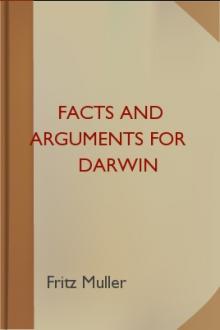Facts and Arguments for Darwin by Fritz Muller (read along books .TXT) 📕

- Author: Fritz Muller
- Performer: -
Book online «Facts and Arguments for Darwin by Fritz Muller (read along books .TXT) 📕». Author Fritz Muller
Project Gutenberg’s Facts and Arguments for Darwin, by Fritz Muller
Copyright laws are changing all over the world. Be sure to check the copyright laws for your country before downloading or redistributing this or any other Project Gutenberg eBook.
This header should be the first thing seen when viewing this Project Gutenberg file. Please do not remove it. Do not change or edit the header without written permission.
Please read the “legal small print,” and other information about the eBook and Project Gutenberg at the bottom of this file. Included is important information about your specific rights and restrictions in how the file may be used. You can also find out about how to make a donation to Project Gutenberg, and how to get involved.
**Welcome To The World of Free Plain Vanilla Electronic Texts**
**eBooks Readable By Both Humans and By Computers, Since 1971**
*****These eBooks Were Prepared By Thousands of Volunteers!*****
Title: Facts and Arguments for Darwin
Author: Fritz Muller
Release Date: September, 2004 [EBook #6475] [Yes, we are more than one year ahead of schedule] [This file was first posted on December 19, 2002]
Edition: 10
Language: English
Character set encoding: ASCII
*** START OF THE PROJECT GUTENBERG EBOOK FACTS AND ARGUMENTS FOR DARWIN ***
Produced by Sue Asscher asschers@bigpond.com
FACTS AND ARGUMENTS
FOR
DARWIN.
BY FRITZ MULLER.
WITH ADDITIONS BY THE AUTHOR.
TRANSLATED FROM THE GERMAN
BY W.S. DALLAS, F.L.S.,
ASSISTANT SECRETARY TO THE GEOLOGICAL SOCIETY OF LONDON.
WITH ILLUSTRATIONS.
LONDON: JOHN MURRAY, ALBEMARLE STREET.
1869.
MR. DARWIN’S WORKS.
A NATURALIST’S VOYAGE ROUND THE WORLD; BEING A JOURNAL OF RESEARCHES INTO THE NATURAL HISTORY AND GEOLOGY OF COUNTRIES VISITED. Post 8vo. 9 shillings.
THE ORIGIN OF SPECIES, BY MEANS OF NATURAL SELECTION; OR, THE PRESERVATION OF FAVOURED RACES IN THE STRUGGLE FOR LIFE. WOODCUTS. Post 8vo. 15 shillings.
THE VARIOUS CONTRIVANCES BY WHICH BRITISH AND FOREIGN ORCHIDS ARE FERTILISED BY INSECTS, AND ON THE GOOD EFFECTS OF INTERCROSSING. Woodcuts, Post 8vo. 9 shillings.
THE VARIATION OF ANIMALS AND PLANTS UNDER DOMESTICATION. Illustrations. 2 volumes, 8vo. 28 shillings.
TRANSLATOR’S PREFACE.
My principal reason for undertaking the translation of Dr. Fritz Muller’s admirable work on the Crustacea, entitled ‘Fur Darwin,’ was that it was still, although published as long ago as 1864, and highly esteemed by the author’s scientific countrymen, absolutely unknown to a great number of English naturalists, including some who have occupied themselves more or less specially with the subjects of which it treats. It possesses a value quite independent of its reference to Darwinism, due to the number of highly interesting and important facts in the natural history and particularly the developmental history of the Crustacea, which its distinguished author, himself an unwearied and original investigator of these matters, has brought together in it. To a considerable section of English naturalists the tone adopted by the author in speaking of one of the greatest of their number will be a source of much gratification.
In granting his permission for the translation of his little book, Dr. Fritz Muller kindly offered to send some emendations and additions to certain parts of it. His notes included many corrections of printers’ errors, some of which would have proved unintelligible without his aid, some small additions and notes which have been inserted in their proper places, and two longer pieces, one forming a footnote near the close of Chapter 11, the other at the end of Chapter 12, describing the probable mode of evolution of the Rhizocephala from the Cirripedia.
Of the execution of the translation I will say but little. My chief object in this, as in other cases, has been to furnish, as nearly as possible, a literal version of the original, regarding mere elegance of expression as of secondary importance in a scientific work. As much of Dr. Muller’s German does not submit itself to such treatment very readily, I must beg his and the reader’s indulgence for any imperfections arising from this cause.
W.S.D.
LONDON, 15TH FEBRUARY, 1869.
AUTHOR’S PREFACE.
It is not the purpose of the following pages to discuss once more the arguments deduced for and against Darwin’s theory of the origin of species, or to weigh them one against the other. Their object is simply to indicate a few facts favourable to this theory, collected upon the same South American ground, on which, as Darwin tells us, the idea first occurred to him of devoting his attention to “the origin of species,—that mystery of mysteries.”
It is only by the accumulation of new and valuable material that the controversy will gradually be brought into a state fit for final decision, and this appears to be for the present of more importance than a repeated analysis of what is already before us. Moreover, it is but fair to leave it to Darwin himself at first to beat off the attacks of his opponents from the splendid structure which he has raised with such a master-hand.
F.M.
DESTERRO, 7TH SEPTEMBER, 1863.
CONTENTS.
CHAPTER 1. INTRODUCTORY.
CHAPTER 2. THE SPECIES OF MELITA.
CHAPTER 3. MORPHOLOGY OF CRUSTACEA.
CHAPTER 4. SEXUAL PECULIARITIES AND DIMORPHISM.
CHAPTER 5. RESPIRATION IN LAND CRABS.
CHAPTER 6. STRUCTURE OF THE HEART IN EDRIOPHTHALMA.
CHAPTER 7. DEVELOPMENTAL HISTORY OF PODOPHTHALMA.
CHAPTER 8. DEVELOPMENTAL HISTORY OF EDRIOPHTHALMA.
CHAPTER 9. DEVELOPMENTAL HISTORY OF ENTOMOSTRACA, CIRRIPEDES, AND RHIZOCEPHALA.
CHAPTER 10. ON THE PRINCIPLES OF CLASSIFICATION.
CHAPTER 11. ON THE PROGRESS OF EVOLUTION.
CHAPTER 12. PROGRESS OF EVOLUTION IN CRUSTACEA.
HISTORY OF CRUSTACEA.
CHAPTER 1. INTRODUCTORY.
When I had read Charles Darwin’s book ‘On the Origin of Species,’ it seemed to me that there was one mode, and that perhaps the most certain, of testing the correctness of the views developed in it, namely, to attempt apply them as specially as possible to some particular group of animals. such an attempt to establish a genealogical tree, whether for the families of a class, the genera of a large family, or for the species of an extensive genus, and to produce pictures as complete and intelligible as possible of the common ancestors of the various smaller and larger circles, might furnish a result in three different ways.
1. In the first place, Darwin’s suppositions when thus applied might lead to irreconcilable and contradictory conclusions, from which the erroneousness of the suppositions might be inferred. If Darwin’s opinions are false, it was to be expected that contradictions would accompany their detailed application at every step, and that these, by their cumulative force, would entirely destroy the suppositions from which they proceeded, even though the deductions derived from each particular case might possess little of the unconditional nature of mathematical proof.
2. Secondly, the attempt might be successful to a greater or less extent. If it was possible upon the foundation and with the aid of the Darwinian theory, to show in what sequence the various smaller and larger circles had separated from the common fundamental form and from each other, in what sequence they had acquired the peculiarities which now characterise them, and what transformations they had undergone in the lapse of ages,—if the establishment of such a genealogical tree, of a primitive history of the group under consideration, free from internal contradictions, was possible,—then this conception, the more completely it took up all the species within itself, and the more deeply it enabled us to descend into the details of their structure, must in the same proportion bear in itself the warrant of its truth, and the more convincingly prove that the foundation upon which it is built is no loose sand, and that it is more than merely “an intellectual dream.”
3. In the third place, however, it was possible, and this could not but appear, prima facie, the most probable case, that the attempt might be frustrated by the difficulties standing in its way, without settling the question, either way, in a perfectly satisfactory manner. But if it were only possible in this way to arrive for oneself at a moderately certain independent judgment upon a matter affecting the highest questions so deeply, even this alone could not but be esteemed a great gain.
Having determined to make the attempt, I had in the first place to decide upon some particular class. The choice was necessarily limited to those the chief forms of which were easily to be obtained alive in some abundance. The Crabs and Macrurous Crustacea, the Stomapoda, the Diastylidae, the Amphipoda and Isopoda, the Ostracoda and Daphnidae, the Copepoda and Parasita, the Cirripedes and Rhizocephala of our coast, representing the class of Crustacea with the deficiency only of the Phyllopoda and Xiphosura, furnished a long and varied, and at the same time intimately connected series, such as was at my command in no other class. But even independently of this circumstance the selection of the Crustacea could hardly have been doubtful. Nowhere else, as has already been indicated by various writers, is the temptation stronger to give to the expressions “relationship, production from a common fundamental form,” and the like, more than a mere figurative signification, than in the case of the lower Crustacea. Among the parasitic Crustacea, especially, everybody has long been accustomed to speak, in a manner scarcely admitting of a figurative meaning, of their arrest of development by parasitism, as if the transformation of species were a matter of course. It would certainly never appear to any one to be a pastime worthy of the Deity, to amuse himself with the contrivance of these marvellous cripplings, and so they were supposed to have fallen by their own fault, like Adam, from their previous state of perfection.
That a great part of the larger and smaller groups into which this class is divided, might be regarded as satisfactorily established, was a further advantage not to be undervalued; whilst in two other classes with which I was familiar, namely, the Annelida and Acalephae, all the attempted arrangements could only be considered preliminary revisions. These undisplaceable groups, like the sharply marked forms of the hard, many-jointed dermal framework, were not only important as safe starting points and supports, but were also of the highest value as inflexible barriers in a problem in which, from its very nature, fancy must freely unfold her wings.
When I thus began to study our Crustacea more closely from this new stand-point of the Darwinian theory,—when I attempted to bring their arrangements into the form of a geological tree, and to form some idea of the probable structure of their ancestors,—I speedily saw (as indeed I expected) that it would require years of preliminary work before the essential problem could be seriously handled. The extant systematic works generally laid more weight upon the characters separating the genera, families and orders, than upon those which unite the members of each group, and consequently often furnished but little employable material. But above all things a thorough knowledge of development was indispensable, and every one knows how imperfect is our present knowledge of this subject. The existing deficiencies were the more difficult to supply, because, as Van Beneden remarks with regard to the Decapoda, from the often incredible difference in the development of the most nearly allied forms, these must be separately studied—usually family by family, and frequently genus by genus—nay, sometimes, as in the case of Peneus, even species by species; and because these investigations, in themselves troublesome and tedious, often depend for their success upon a lucky chance.
But although the satisfactory completion of the “Genealogical tree





Comments (0)